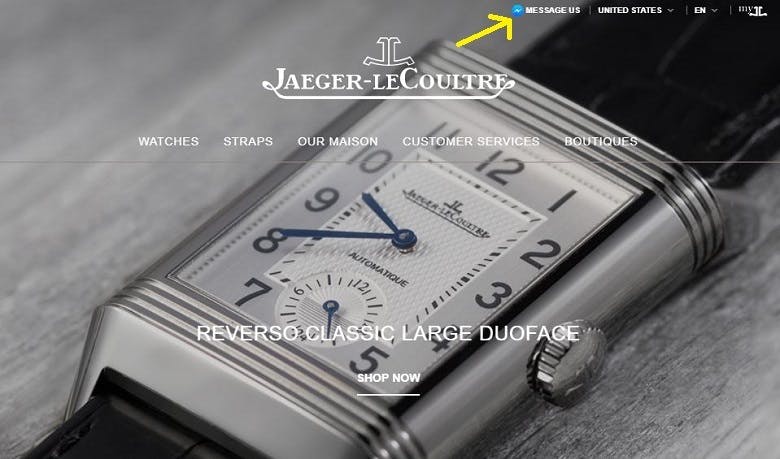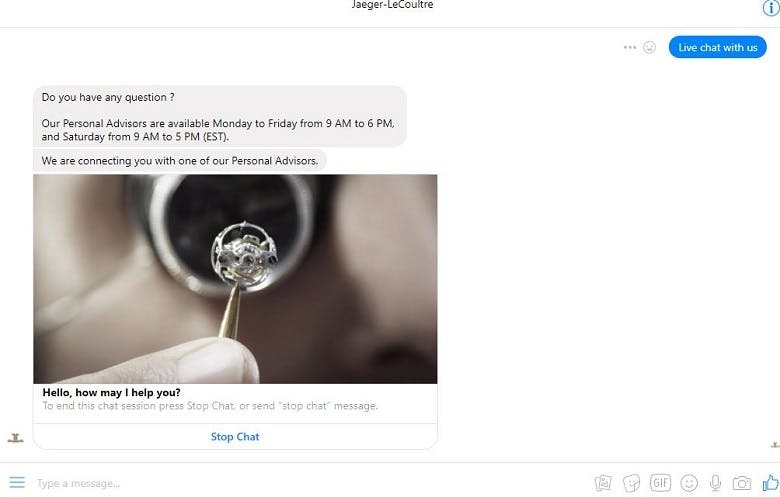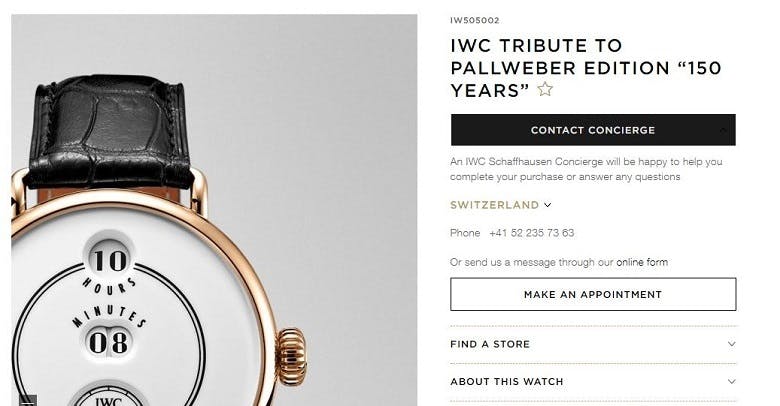That being said, reports suggest that while 9% of soft luxury goods are sold online, this decreases to just 4-5% for hard luxury goods – i.e. ‘timeless’ items like watches or fine jewellery.
It seems the argument that consumers only want to buy hard goods in-store has some weight. However, some hard luxury brands are keen to close the gap, with many finding new ways to entice consumers online.
So, how is the hard luxury market embracing ecommerce? Here’s more on the story.
Social and live chat – Jaeger-LeCoultre
With the rise of platforms like Instagram and Pinterest playing a part in discovery and search, it would be foolish to disregard digital channels entirely. Even luxury brands that don’t sell online tend to have a large social media presence.
For those that have entered ecommerce, social also presents big opportunities for customer service, helping to bridge the gap between the online and offline luxury experience.
Watch brand Jaeger-LeCoultre is one example of this, having launched a chatbot designed to guide customers along the path to purchase, and to help to combat concerns that might usually take them in-store.
With the bot promoted on the homepage, it’s clear that the brand is keen for consumers to make this connection between customer service and social.

The bot essentially acts like a personal shopper or assistant, helping users to decide on a watch or specific details like straps. Pleasingly, there’s also a live chat element, meaning customers are more likely to feel like they’re getting the same kind of service as they would in-store.
While this doesn’t outweigh the ability to see and feel a product in the context of real-life, it certainly helps to alleviate the somewhat disconnected and impersonal feeling that comes along with buying online.

Four reasons luxury brands are embracing influencers
Accessibility and delivery – Toplife
China is one market in particular where luxury retail is booming. Last year, Chinese shoppers accounted for 32% of sales worldwide, with goods purchased making up 8% of the global total.
This is reportedly due the rise of China’s middle classes, and more specifically, a new generation of millennial shoppers who are increasingly willing to spend money on high-end brand names.
It’s also thanks to the likes of JD.com – one of China’s largest ecommerce platforms, which sells luxury goods alongside other big-spend items like home appliances and electronics.
Last year, JD.com launched Toplife, which is a site that specialises in full-price luxury goods. While it faces stiff competition from rival Alibaba (and its Luxury Pavilion section), Toplife is able to differentiate itself with greater accessibility. As an invite-only site, Luxury Pavilion aligns with the idea of luxury fashion as exclusive and premium – perhaps only for a certain type of customer. In contrast, Toplife is open and accessible to all, focusing on the growing desire for great service rather than heritage or price.
In a bid to cater to the needs of online shoppers, Toplife has also implemented the ‘JD luxury express’ delivery service. It involves specially-trained delivery personnel using electric vehicles to deliver goods (rather than standard scooters) within 24 hours.
As well as satisfying luxury shoppers with its delivery options, JD.com has managed to entice more hard luxury brands onto its platform because of it. Last year, Farfetch also agreed on a partnership with JD.com to operate directly in China.
For more on JD.com, subscribers can download Econsultancy’s ‘More than Ecommerce’ report.)
Greater convenience – IWC
In other markets where delivery remains a challenge, hard-luxury retailers are still intent on finding ways to facilitate online purchases where possible.
Click and collect is one viable alternative. Selfridges, which carries a range of hard luxury brands including Tiffany and Cartier, has extended its service to include jewellery and watches. Burberry has also been a pioneer of this kind of service, with its click and collect option reportedly accounting for 15% of its online sales.
Another way brands are catering to online shoppers is by providing as many options as possible. Last year, Swiss watch brand IWC revamped its website to improve its omni-channel offerings, with the changes aiming to increase the chances of keeping customers in the sales funnel (regardless of channel).
Now, each product page gives users the option to contact a ‘concierge’ to help complete a purchase or answer questions, as well as the opportunity to make an appointment to finalise it in-store. Other features like the ability to create a wishlist also feed in to the idea of luxury shopping as an on-going journey rather than a quick fix.

High vs. low – Thomas Sabo
Finally, an area that hard-luxury retailers cannot seem to decide on. Price.
Some brands are intent on maintaining a sense of exclusivity – only selling a limited number of items online and reserving the majority for in-store. Meanwhile, others are taking the opposite tack, by introducing more affordable ranges to entice younger or less wealthy customers.
The latter strategy also appears to be due to the rising popularity of ‘affordable luxury’ brands like Thomas Sabo and Monica Vinader. Somewhere in-between Pandora and Cartier, these brands are tapping into the growing desire for hard-luxury that is both enduring and more affordable.
It all depends on the brand’s values of course, coupled with its willingness to potentially dilute factors like heritage and premium-status for sales.
Regardless, it’s worth considering that consumers might not be so polarised in terms of what they want from luxury brands, with omni-channel perhaps presenting the greatest opportunity of all.
Luxury ecommerce review: Is Balenciaga’s ‘normcore’ website more than a gimmick?

Comments